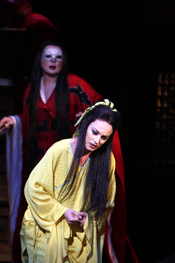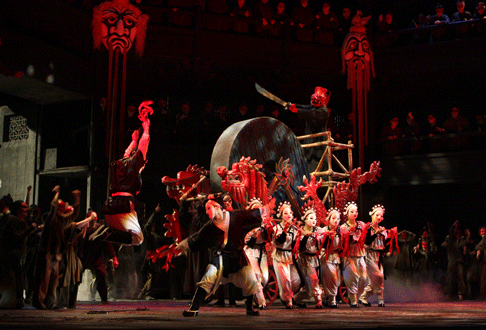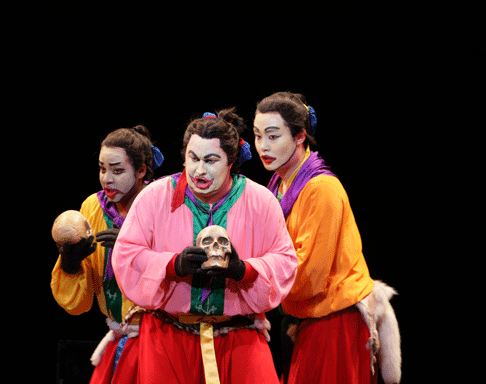17 May 2009
Turandot — Washington National Opera
Bringing Andrei Şerban’s Turandot to the Washington National Opera as a season finale really means finishing the year with a bang.

Bringing Andrei Şerban’s Turandot to the Washington National Opera as a season finale really means finishing the year with a bang.
Created by the Royal Opera House in 1984, with the current WNO director Placido Domingo as Calaf and Gwyneth Jones in the title role, the production has since been revived there fifteen times, staged over fifty times by opera houses around the world, and celebrates its 25th season this year. With all due respect to the original cast, this unprecedented success has nothing to do with them, but rather with the interpretive genius of the director Andrei Şerban, and the fantastic inventiveness of the set and costume designer Sally Jacobs, whose original ideas were presented last night at the WNO stage.
Şerban’s Turandot is staged: literally staged, as the opera is played out in a traditional Chinese theater, with the chorus occupying the galleries as it comments and participates in the action. The theater is decorated by gigantic masks, representing the heads of Turandot’s slain suitors. The characters are also masked (most also wear a white-face make-up, creating a mask-over-mask effect), their gestures deliberate and stylized. The colors are vibrant, with the crimson reds dominating. The emperor’s golden throne, lowered from the ceiling to hover above the crowd in Acts 2 and 3, is a striking effect, and the sword-wielding female dancers in white masks are so chilling, they are downright creepy.
 Sabina Cvilak (fore) as Liu, Maria Guleghina (back) as Turandot
Sabina Cvilak (fore) as Liu, Maria Guleghina (back) as Turandot
The opening night was the usual spectacle of tuxes and gowns. My husband
really liked the live Terracotta Warrior in the lobby; I thought it was,
perhaps, a tad over the top. There were inevitable first-night kinks; and no,
I am not talking about an unidentified heavy object crashing backstage
half-way through Turandot’s opening aria, which all those present have
been determined to forget. The kinks concerned the issues of balance and
timing, as the conductor Keri-Lynn Wilson tried to keep various sections of
the large orchestra, chorus, and soloists in a perfect synchronicity required
by Puccini’s famously complex score. The first act in particular
occasionally felt like a gigantic house of cards, shaking slightly, just on
the verge of collapse. Thankfully, it never quite did, and as the performance
progressed, the tremors mostly subsided, save for only an occasional
aftershock.
Argentine tenor Dario Volonté as Calaf hit every note; he demonstrated the fiery metallic timbre, and the alternatively aggressive and brooding personality essential for his character. Yet, his voice had no lyricism, no warmth, and most importantly, no sustaining power — at least not last night — that would have allowed the listener time to appreciate all those head-spinning highs before they sputtered and died like wet Chinese fireworks. His Act 3 pièce de resistance, “Nessun dorma”, was so rushed that the orchestra had trouble keeping up. There was no cantilena, no luxurious lingering on the final “Vincero!”, and consequently, Turandot’s most glorious moment and one of Puccini’s best-known tunes, probably for the first time in its history, evaporated without even a smattering of applause.
 Scene from Act I
Scene from Act I
The first applause of the night belonged to Slovenian soprano Sabina Cvilak as Liù, and deservedly so. Her tiny, brittle figure, dwarfed by the scenery and the other characters, was an embodiment of Puccini’s fragile, tragic heroine, the most human character in Turandot (in a stroke of directorial inventiveness, Liù is never masked). And the vocal interpretation was spot-on: pure, crystalline highs; easy, unforced delivery; power to soar above the orchestra at will, but exercised sparingly, in preference to the heart-breaking pianissimo that somehow, miraculously, was perfectly audible (kudos here also to Ms Wilson for her sensitive conducting).
There could have been no greater contrast between Ms Cvilak’s Liù and Princess Turandot as presented by celebrated Russian dramatic soprano Maria Guleghina. Here, everything was the opposite: tall, imposing figure; stylized kabuki gestures; earth-shattering power of the voice that waited until the opera’s finale to drop below fortissimo and was meanwhile so intimidating, one barely noticed that it was almost impossible to discern the words that came out of Ms Guleghina’s mouth. Like the “citizens of Peking,” we simply submitted to the iron will of the Daughter of Heaven, and waited for precise instructions from her Mandarin.
 Norman Shankle, Nathan Herfindal, Yingxi Zhang as Ping, Pang and Pong
Norman Shankle, Nathan Herfindal, Yingxi Zhang as Ping, Pang and Pong
The Mandarin, Ukrainian Okeskandr Pushniak, was acceptable if not at all intimidating in his tiny part, and was much more interesting to look at than to hear, clad as he was in one of Sally Jacobs’ fabulously colorful creations. Much better — a highlight of the evening, in fact — were Ping, Pang, and Pong (Nathan Herfindahl, Norman Shankle, and Yingxi Zhang, respectively), who garnered accolades for their nice comic timing, and delivering strong vocal performances while endlessly moving, dancing, and literally doing cartwheels around the stage. Indeed, the choreography created by Kate Flatt for their parts and throughout Turandot proved to be one of the strongest elements of the production. Particularly interesting was the fluid continuity of stylized gestures and movements that all performers shared. Blurring the boundaries between the soloists, the chorus, and the dancers, the technique delivered a stunningly unified visual effect.
This unity was clearly the stage director’s goal, realized with the support of Jacobs’ designs, Flatt’s choreography, and F. Mitchell Dana’s lighting. For this alone, it is worth seeing Andrei Şerban’s magnificent interpretation of the Puccini classic — now, at 25, a classic in its own right.
Olga Haldey